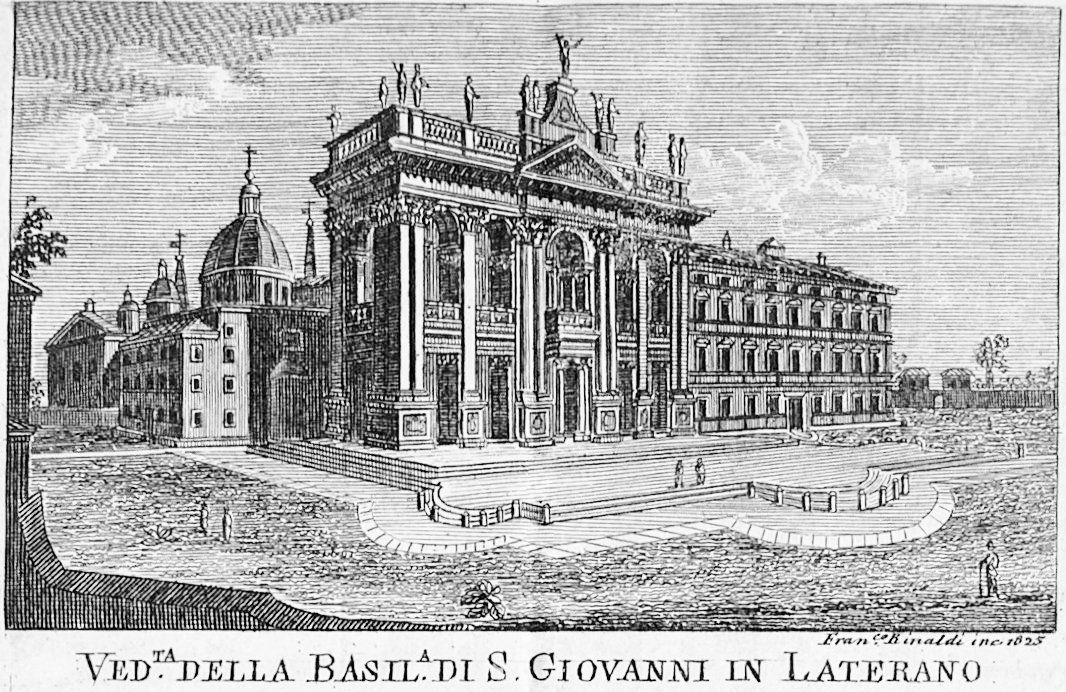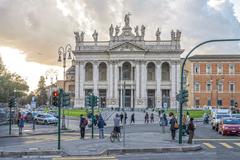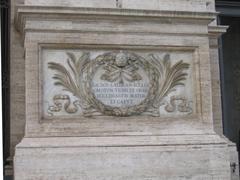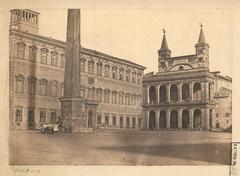
Archbasilica of St. John Lateran: Visiting Hours, Tickets, and Historical Significance in Rome
Date: 14/06/2025
Introduction
The Archbasilica of St. John Lateran—known in Italian as Basilica di San Giovanni in Laterano—is the oldest and most important papal basilica in Rome. As the cathedral of the Bishop of Rome (the Pope), it is honored as the “mother and head of all churches in Rome and the world” (“Omnium urbis et orbis ecclesiarum mater et caput”). Founded in the early 4th century by Emperor Constantine the Great on the site of the Laterani family palace, this basilica marks a pivotal transition from Roman paganism to Christianity and continues to play a central role in Catholic tradition and worship (myromepass.com, Britannica).
This article offers a comprehensive, non-repetitive guide to the Archbasilica’s history, architectural and artistic highlights, religious significance, practical visitor information (including opening hours and ticketing), accessibility, and travel tips. Whether you are a pilgrim, a history enthusiast, or a traveler eager to explore Rome’s spiritual and architectural gems, this guide will help you make the most of your visit.
Table of Contents
- Historical Overview
- Religious and Cultural Significance
- Architectural and Artistic Features
- Visiting Information
- Nearby Attractions
- Frequently Asked Questions (FAQ)
- Conclusion
- References
Historical Overview
Foundation and Early Christian Era
The origins of the Archbasilica date to 324 CE when Emperor Constantine, following his victory at the Battle of the Milvian Bridge, gifted the Lateran Palace to the Bishop of Rome. The church, consecrated by Pope Sylvester I and initially dedicated to Christ the Savior, soon became the premier Christian basilica in the Western world (myromepass.com). Over time, its dedication expanded to include St. John the Baptist and St. John the Evangelist, reflecting its growing spiritual importance.
The basilica’s original structure set the benchmark for Christian architecture, adopting the Roman civic basilica blueprint: a vast nave, side aisles, and an apse. This layout became the model for countless later churches (Museos).
Medieval, Renaissance, and Baroque Restorations
Throughout its history, St. John Lateran has survived fires, earthquakes, and multiple reconstructions. After devastating fires in the 14th century and the papacy’s temporary move to Avignon, the basilica underwent major restorations. The 16th and 17th centuries saw extensive rebuilding, culminating in Alessandro Galilei’s monumental Baroque façade in 1735 (The Geographical Cure). Architect Francesco Borromini’s 17th-century work on the nave and apse introduced grand arches and niches, later filled with statues of the apostles.
The adjoining Lateran Palace served as the papal residence for centuries, and the Lateran Baptistery—built in the 4th century—remains the oldest of its kind in Christendom (RomeSite).
Religious and Cultural Significance
As the cathedral of the Pope, St. John Lateran is not only a place of worship but also a symbol of papal authority and the Catholic Church’s global unity (rome.net). The basilica has hosted five ecumenical Lateran Councils which have shaped Catholic doctrine and practice.
The basilica houses significant relics, including the heads of Saints Peter and Paul above the high altar and the Holy Door, which is opened during Jubilee years as a symbol of spiritual renewal. Adjacent to the basilica, the Scala Sancta (Holy Stairs) is believed to be the staircase Jesus ascended in Pontius Pilate’s palace; pilgrims often climb these steps on their knees in penance (artandtraditiontours.com).
During major liturgical celebrations, especially the Jubilee, the basilica becomes a focal point for pilgrims seeking indulgences and spiritual grace.
Architectural and Artistic Features
- Façade: Galilei’s 18th-century travertine façade is a late Baroque masterpiece, crowned with 15 colossal statues.
- Nave and Apse: Borromini’s arches and the 13th-century apse mosaic by Jacopo Torriti depict Christ, Mary, saints, and angels, representing medieval and baroque artistry.
- Statues of the Apostles: The nave’s 12 monumental niches are filled with statues by renowned Rococo artists, each with dynamic, expressive poses (Rome.info).
- Cloister: The 13th-century Cosmatesque cloister, by the Vassalletto family, is famed for its twisted marble columns and mosaic inlays (Visit Vatican).
- Lateran Baptistery: The octagonal baptistery, richly decorated, influenced the design of later Christian baptisteries across Europe.
- Scala Sancta and Sancta Sanctorum: The Holy Stairs, covered in walnut for protection, lead to the Sancta Sanctorum chapel, renowned for 13th-century frescoes (Museos).
- Lateran Obelisk: Standing at 32.18 meters, this is the tallest ancient Egyptian obelisk in the world, brought from Karnak and installed in the piazza (Wikipedia).
Visiting Information
Hours and Admission
- Basilica: Open daily, typically from 7:00 or 7:30 AM to 6:00 or 6:30 PM. Exact hours may vary during special liturgical events or holidays—check the official website before visiting.
- Cloister and Museum: Usually open from 9:00 AM to 6:00 PM.
- Tickets: Entry to the main basilica is free. Tickets for the cloister, baptistery, treasury, and Sancta Sanctorum are available as combination passes (approx. €10–€15). Purchase tickets online or at the entrance (rome.net).
Accessibility
The basilica is wheelchair accessible, with ramps and elevators available. Some historic areas, such as the Scala Sancta, may be challenging for those with limited mobility.
Getting There
- Metro: Line A or C to San Giovanni station; a five-minute walk from there.
- Bus/Tram: Multiple lines stop at Piazza di San Giovanni in Laterano.
- On Foot: The basilica’s central location makes it easy to combine with other major Roman sites.
Travel and Etiquette Tips
- Dress Code: Modest attire is required—shoulders and knees covered.
- Security: Expect airport-style checks; glass and aerosols are not allowed.
- Photography: Permitted without flash or tripods in most areas; restrictions may apply in certain chapels.
- Best Times to Visit: Early morning or late afternoon for fewer crowds; avoid May 1st due to the annual concert in the piazza.
Nearby Attractions
Combine your visit with nearby sites such as:
- Basilica of Santa Maria Maggiore
- Basilica of Santa Croce in Gerusalemme
- The ancient Aurelian Walls
- San Giovanni neighborhood’s cafés and shops
Frequently Asked Questions (FAQ)
What are the opening hours of St. John Lateran?
The basilica is open daily, generally from 7:00 or 7:30 AM to 6:00 or 6:30 PM. Check the official website for up-to-date hours.
Is there an entrance fee?
Entry to the main basilica is free. Tickets are required for the cloister, baptistery, treasury, and Holy Stairs.
How do I get there?
Take Metro Line A or C to San Giovanni station, or use buses/trams serving Piazza di San Giovanni in Laterano.
Are guided tours available?
Yes, guided tours and audio guides are available and highly recommended for in-depth exploration.
Is the basilica accessible to wheelchair users?
Most areas are accessible; contact the basilica in advance for specific assistance.
Can I take photos?
Photography is allowed without flash; restrictions may apply in certain chapels.
Conclusion
The Archbasilica of St. John Lateran is a living testament to Rome’s religious, artistic, and cultural legacy. As the Pope’s cathedral and the first Christian basilica built in the city, it embodies centuries of faith, history, and architectural excellence. With free entry, accessible facilities, and a wealth of sacred art and relics, it is a must-see for anyone visiting Rome. Be sure to plan ahead for the best experience, and consider exploring nearby sites to enrich your journey.
For the latest information, virtual tours, and travel updates, visit the official Archbasilica website. Enhance your visit with the Audiala app’s guided audio tours and stay connected via social media for up-to-date news on Rome’s historic sites.
References
- Archbasilica of St. John Lateran, 2024, MyRomePass
- Basilica of St. John Lateran, 2024, Britannica
- The History of St. John Lateran, 2024, Art and Tradition Tours
- St. John Lateran Basilica, 2024, Rome.net
- Archbasilica of Saint John Lateran, 2024, Museos
- Basilica of San Giovanni in Laterano, 2024, Rome.us
- Guide to St. John Lateran, 2024, The Geographical Cure
- Archbasilica of St. John Lateran, 2024, Rome.info
- Archbasilica of Saint John Lateran, 2024, Rome-Tourism
- Archbasilica of Saint John Lateran, 2024, RomeSite
- Archbasilica of Saint John Lateran, 2024, Visit Vatican
- Archbasilica of Saint John Lateran, 2024, Wikipedia




















































































































































































































































